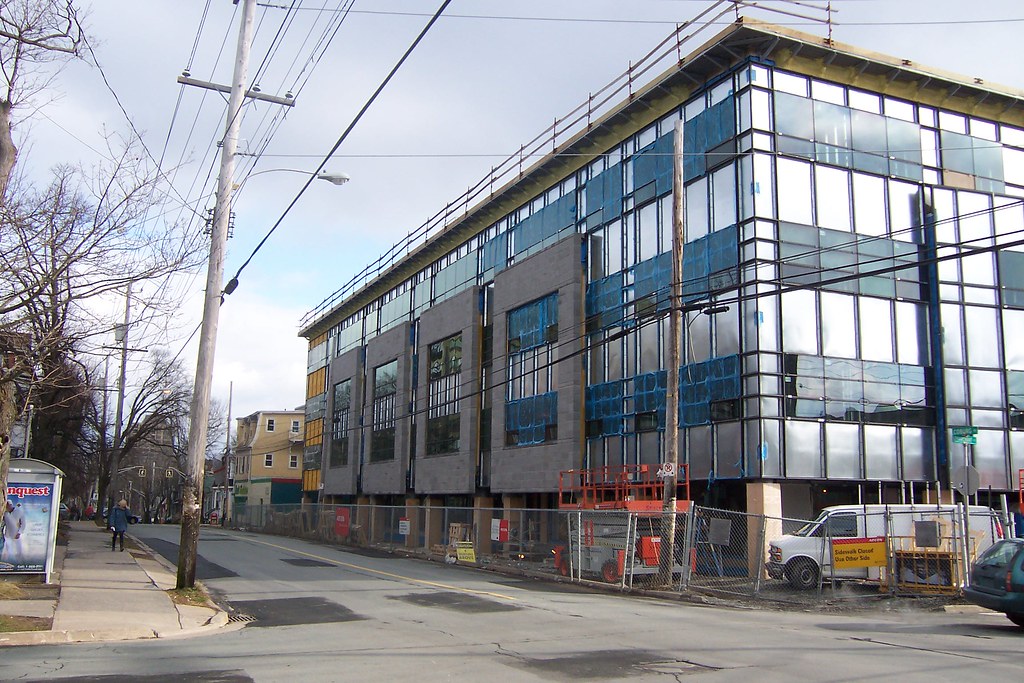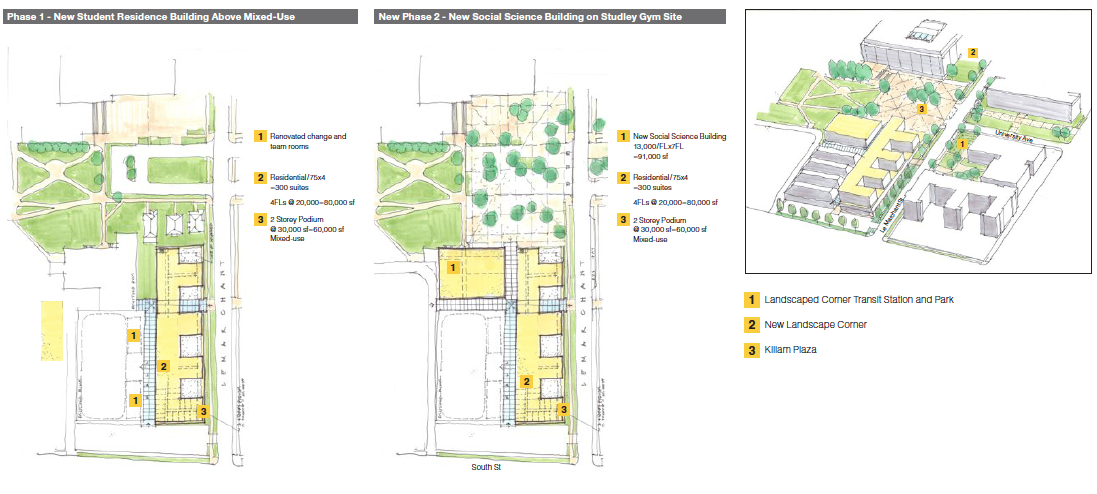
HALIFAX – About one month ago, I wrote an article for the Dalhousie Gazette on the updated campus master plan [PDF], which is in the final review stages before being implemented. Dal has made some effort to get good public feedback — they’ve set up a blog dedicated to the plan as well as an official page on the University website — these discussions haven’t gotten much press or sparked too much attention, on or off campus.
This is too bad, since the plan will have a big impact not only on Dal students but the wider community. Included in the proposals are separated bike lanes, a pedestrian plaza, massive new buildings and a transit terminal on LeMarchant Street. While my article mostly focuses on the changes in store for Studley Campus, my hope is that re-positing it here will bring a little more attention and generate the much needed discussion these important plans deserve.
Master plans are always exciting documents, and Dalhousie’s updated Campus Master Plan is no exception. Full of colourful diagrams, maps and tables, plans give us the rare opportunity to shape the future landscape of our communities to better reflect the goals and values we think are important.
Judged from this perspective, there’s much to praise in Dal’s new plan. Students’ cries for improved active transportation and public transit infrastructure have finally been heard. The master plan proposes putting bike lanes along University Avenue and turning the now vacant corner outside the Student Union Building into a “landscaped transit terminal.”
For pedestrians too, much is in store. A new multi-level parkade to be built next to the Dalplex will rid campus of the haphazard scattering of cars currently parked in many of the university’s busiest outdoor spaces. With the cars gone, a pedestrian plaza will be built at the top of University Avenue to act as a focal point for student social life.
In terms of their overall cost and impact in comparison to other measures called for in the plan, however, the bike lanes, pedestrian plaza and bus terminal are little more than fancy garnishes packaging the more ambitious goals at the centre of the Master plan: to quickly make Dalhousie much bigger by constructing massive new residences and academic buildings.
With Dalhousie currently running at capacity and enrolment projected to increase by 2,500 students in the next four years – a 16.4 per cent increase from last year – the status quo simply won’t cut it any more. The problem is there’s only so much space on campus where new development can go. Cue the planners.
Phase one of the plan proposes to address the demands of massive enrolment increases by building a six or seven storey mixed-use student residence on LeMarchant Street across from Risley Hall and the SUB. The building will have as many as 300 living “suites” on the upper floors, while the ground level will be an “enclosed concourse” – picture a single storey Park Lane Mall – complete with “food services,” a pharmacy, a convenience store, “games” and, get this: a barbershop.
Making room for this residence, however, will mean demolishing the five Dal houses, including the new Grad House, that are currently occupying the site, most of which are in good condition or have been recently renovated.
Indeed, every single house owned by Dal on Studley campus has been listed as a “priority building” by the planners, a label used to identify “those properties considered to be of significance to the plan for future campus development.” This doesn’t mean they will necessarily be torn down, but it doesn’t mean they’ll be protected either.
In this era of “sustainability,” while new development might promise greater efficiency and more environmentally friendly design, razing perfectly good buildings hardly strikes one as following the sustainability mantra. But that’s a question for an engineer to tackle, and besides, there are other more important reasons to be distressed by the proposed demolitions and new residence building.
To start with, there’s the architectural heritage argument. Built in the 1920s and 1930s, the LeMarchant Street houses are not only some of the oldest buildings on Studley, but they help to integrate campus with the surrounding residential neighbourhood through their scale and style. It’s these houses that give Dal its uniquely Maritime feel, setting it apart from other Canadian university campuses – a draw for many out-of-province students.
They also provide intimate spaces for important student and community services that rely on the more personal and relaxed atmosphere the houses provide. In fact, most of the university services involving the greater community can be found in these old houses, like the Dalhousie Women’s Centre, the Native Counselling Unit, the College of Continuing Education, the School of Social Work and the Transition Year Program offices, not to mention almost all of Dalhousie’s remaining non-traditional residences.
But even for the majority of students who never step foot in these old houses, their demolition doesn’t bode well for the future of campus life.
The famous urban thinker Jane Jacobs once wrote that “old ideas can sometimes use new buildings. New ideas must use old buildings.” With momentum building for bringing more affordable and local food options onto campus, these new businesses and student societies will need places to serve from; the McCain lobby can only go so far.
But independent start-ups need appropriately sized spaces with affordable rent, not industrial-sized cafeterias with a big price tag that will surely come part and parcel with the “indoor concourse” proposed in the new residence building. So without even explicity writing it, the “food services, pharmacy, variety/convenience” described in the plan simply means more Sodexho, a Shoppers Drugmart or Lawton’s and another unremarkable Big General.
Cafés such as Coburg Coffee or Just Us! Café are only possible in older buildings because of their cheaper rent, more intimate scale and cozy atmosphere. The same goes for restaurants. So if new student-run organizations like Campus Action on Food and Tuppy Thursdays or local independent businesses are ever going to find a home on campus, it’ll be in these old houses and not in new residence buildings tailored to the requirements of industrial food distributors like Sodexo.
So while destroying five houses to make room for much needed new residences may not seem like the end of the world, it sets a bad precedent for all the other “priority” houses on campus, especially since the LeMarchant Street houses are in good condition and particularly well-located.
Grad students also won’t be pleased to hear that once their new bar is torn down after having only been open for a year or two, the Grad House’s next home will be along side Sodexho and Shoppers in the mall-like concourse of a first year residence building.
These kinds of transformations are a perfect example of what Dal is potentially loosing by replacing its historical houses with massive new buildings. It’s like choosing the Grawood over the Grad House, and for many students, that’s the wrong choice.
There are other solutions to residence shortages that don’t involve the wrecking ball. Why not try innovative architecture that works around older buildings or adaptively reusing other structures, like the Studley Gym – another building soon to be demolished by the stroke of a planner’s pen – before razing historic houses. Or by developing any of the huge surface parking lots on campus before destroying perfectly good buildings.
The Master Plan’s colourful bike lanes, pedestrian plaza and transit terminal – all long overdue and relatively inexpensive pieces of infrastructure that the planners would be stupid not to include – shouldn’t distract us from the bigger picture. Dalhousie is growing, and that growth requires new buildings. But does the development proposed in the plan really reflect the same values symbolized by bike lanes and improved public transit?
Sustainability isn’t just about losing the car; it’s about losing the lifestyle where we replace rather than reuse.
Re-posted from the Dalhousie Gazette. Photo by Jake Schabas and diagrams from the Dal Master Plan.



2 comments
Université Laval in Quebec City has similar campus infrastructure like what Dalhousie has in store (see: http://www2.ulaval.ca/plan-du-campus/carte-interactive-du-campus.html). The main campus building, the Alphonse-Desjardins, which is comparable to Dalhousie’s SUB, sounds very much like the residence/strip-mall planned for LeMarchant Street. It houses food services (Sodexho), the bookstore, a bank, a barbershop, a pub, and a convenience store. I’m sure a building like this is common in many large universities, but it certainly was not anything I enjoyed as a student. I felt like I was at a shopping-mall rather than a university. Whatever character Dalhousie has left is going to be destroyed by financial interest rather than academic integrity, if it hasn’t been already.
[…] the universities future building plans, and therefore its future priorities. The plan has met with mixed reviews. CAF fears that the plan may have a green face but it masks a disappointing commitment to […]